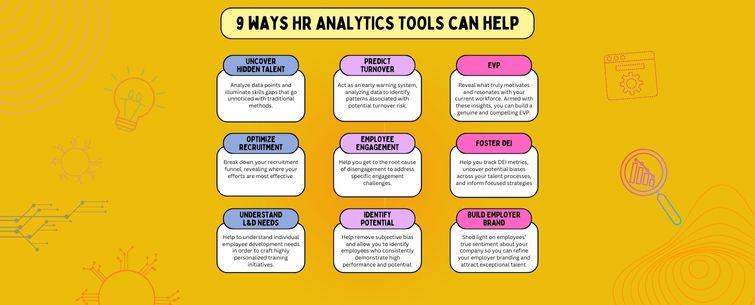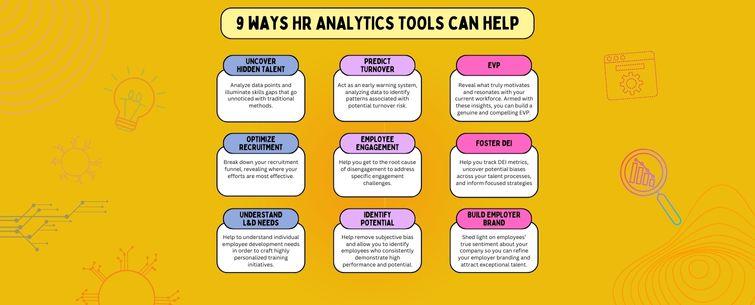You are sitting on precious data: attendance records, performance reviews, employee surveys, etc. Nevertheless, this data is only helpful if you can't transform it into actionable insights and behavioral analysis. And that's where HR analytics tools come into the picture. These solutions help you collect, analyze, and visualize HR data to drive smarter organizational decisions.
Consequently, the right HR analytics tools can significantly elevate your organization's hiring, employee development, and retention strategies. A recent study by Deloitte found that companies using data-driven HR practices are 3x more likely to report significant improvements in their talent strategies.
However, choosing the perfect tools for your specific needs can feel exhausting. Let's break down the essentials of HR analytics tools, their key benefits, and how to select the best solutions to transform your HR processes. Could this transformation be the secret to unlocking your company's full potential?
9 Ways HR Analytics Tools Can Level Up Your HR Game
If you are trying to go over and are overwhelmed by a sea of data and struggling to translate it into actionable insights for your HR strategy, You're not alone. But what if you could leverage your employee data's hidden potential to make smarter talent decisions?
These robust solutions empower you to analyze, visualize, and gain meaningful insights from your HR information. Let's explore nine key ways HR analytics tools can transform your HR game:
1. Uncover Hidden Talent Gaps
HR analytics tools act as a powerful diagnostic tool for your workforce. Analyzing data points can illuminate skills gaps that go unnoticed with traditional methods. Proactively address these gaps through targeted recruitment or upskilling programs to ensure your workforce is equipped for future business needs.
2. Optimize Your Recruitment Spend
Only spend money on recruitment channels with a strategy. HR analytics tools break down your recruitment funnel, revealing where your efforts are most effective. They allow for highly targeted optimization, fine-tuning job postings, or candidate sourcing strategies to directly impact your time-to-hire and reduce overall recruitment costs.
3. Drive Data-Informed Learning & Development
Generic training programs often need to be revised. HR analytics tools enable a granular understanding of individual employee development needs. It paves the way for highly personalized training initiatives with clear performance objectives, ensuring development efforts translate into improved employee performance and business results.
4. Predict Employee Turnover
High turnover can significantly disrupt your organization and undermine your bottom line. HR analytics tools can act as an early warning system, analyzing data like performance reviews and engagement trends to identify patterns associated with potential turnover risk. This proactive approach empowers you to address potential issues and foster an environment where top talent chooses to stay.
5. Improve Employee Engagement
Low morale and disengagement are detrimental to any organization's success. HR analytics tools help you dig below the surface of employee surveys to get to the root of the problem. Targeted actions based on these insights can address specific engagement challenges, promoting a more positive and productive work culture.
6. Identify Top Performers and High Potentials
It's crucial to recognize and nurture top talent within your organization. HR analytics tools help remove subjective bias, allowing you to identify employees who consistently demonstrate high performance and potential for advancement. This data-backed approach allows for targeted development investment, ensuring a strong leadership pipeline for the future.
7. Create a Compelling Employee Value Proposition (EVP)
A strong EVP is essential to attract and retain the best. HR analytics tools reveal what truly motivates and resonates with your current workforce. Armed with these insights, you can build a genuine and compelling EVP that differentiates you in the competitive talent market.
8. Foster Diversity, Equity, & Inclusion (DEI)
Building a truly diverse, equitable, and inclusive workplace is a smart business strategy. HR analytics tools can help you track key DEI metrics, uncover potential biases across your talent processes, and inform focused strategies to create a workplace where everyone has the opportunity to thrive.
9. Build a Stronger Employer Brand
Your employees can be your most powerful brand ambassadors. HR analytics tools can shed light on their true sentiments about your company. By identifying the elements of your employment experience that resonate the most, you can refine your employer branding and attract exceptional talent who aligns with your organization's values and culture.
6 Key Factors When Choosing HR Analytics Tools
With the abundance of HR analytics tools on the market, making an informed decision can be challenging. It's essential to look beyond the surface-level features and focus on factors ensuring the selected solution integrates with your workflow and delivers value.
Let's delve into six key considerations that will guide you in choosing HR analytics tools to meet your needs, streamline processes, and provide actionable insights for strategic decision-making.
1. Ease of Use
A fancy HR analytics tool that only some team members can understand is useless. Prioritize tools with intuitive interfaces, clear documentation, and accessible user support. This will ensure that everyone on your HR team, regardless of data expertise, can effectively extract insights and avoid frustration.
2. Data Integration
Imagine constantly moving data between systems manually. Not a good use of time. Your chosen HR analytics solution should smoothly integrate with your existing HRIS, payroll, applicant tracking systems, and other relevant data sources. This streamlined data flow saves time, reduces errors, and gives you a comprehensive view of your workforce.
3. Reporting & Visualization
HR analytics tools are powerful but must translate raw data into digestible stories. Look for platforms that offer customizable reports, clear dashboards, and engaging data visualizations. This makes it simple to understand trends, identify patterns, and effectively communicate insights to HR colleagues and company leadership.
4. Scalability
Your HR analytics needs will evolve as your business evolves. Choose a platform that can scale alongside your organization, handling increasing data volume and addressing new strategic questions that come with growth. It means looking beyond just your current needs and future-proofing your investment.
5. Security and Compliance
Employee data is sensitive. Any HR analytics solution you choose must prioritize robust security measures and adhere to all relevant data privacy regulations (like GDPR, CCPA, etc.). A data breach is a compliance issue and a devastating blow to an employee's trust.
6. Cost vs. ROI
HR analytics tools represent an investment, so the chosen solution needs to deliver quantifiable value. Evaluate the upfront cost and the long-term return on investment (ROI). Look for tools aligning with your most critical HR goals, whether reducing turnover, improving recruitment, or boosting engagement.
12 Actions to Unlock the Power of HR Analytics Tools
After grasping the benefits of HR analytics and what to look for in a solution, it's time to translate this knowledge into concrete steps. Let's explore tangible actions to maximize the impact of your HR analytics implementation.
Here are 12 essential actions to take as you embark on this journey. Think of them as your roadmap to successfully harnessing the power of data within your HR strategy.
Define Your Goals: Before implementing, clearly outline what you hope to achieve with HR analytics. Do you want to reduce turnover, optimize recruitment, or improve employee engagement?
Identify Key Metrics: Determine the specific metrics to measure progress toward your goals. These could be turnover rates, time-to-hire, employee satisfaction scores, or others closely tied to your objectives.
Assess Your Current Data Landscape: Understand the types of HR data you already collect and where it's stored (HRIS, payroll systems, etc.). This will help determine what needs integration.
Prioritize Data Quality: Even the most sophisticated tools are only helpful if your data is accurate or complete. Implement processes to ensure data consistency and reliability.
Evaluate HR Analytics Solutions: Research potential HR analytics tools, considering the factors we discussed earlier (ease of use, integration, etc.). Request demos or trials to get hands-on experience.
Select and Implement Your Solution: Once you've chosen a tool, follow a structured implementation plan that includes data migration, configuration, and user training.
Train Your HR Team: Ensure your entire HR team is comfortable using the tool and understands how to extract insights. Ongoing training and support are crucial.
Start With Focused Analysis Begin with a few key metrics or questions to avoid overwhelming your team. As you gain proficiency, expand your analysis.
Communicate Insights Effectively Share insights with relevant stakeholders in a clear, visually engaging format. Translate data into actionable recommendations.
Take Action on Insights HR analytics is meaningless without action. Use data-backed insights to drive improvements in HR processes and strategies.
Measure and Evaluate Progress Regularly monitor how your HR analytics initiatives impact your key metrics to measure success and identify areas for refinement.
Embrace Continuous Improvement The world of HR analytics is constantly evolving. Stay up-to-date on new trends and best practices, and consider future upgrades or enhancements as your needs change.
Action Plan: Implementing an HR Analytics Strategy
Step 1: Establish a Data-Driven Mindset: Cultivate a culture throughout your HR team and larger organization that values insights over "gut feelings" in decision-making.
Step 2: Build Your Team: Identify or hire dedicated individuals with data analysis skills or upskill existing HR team members through training and development.
Step 3: Secure Executive Buy-In: Obtain strong support from leadership. Demonstrate the potential ROI of HR analytics to secure necessary resources and facilitate collaboration.
Step 4: Develop and Execute a Strategic Roadmap: Outline a phased approach with achievable milestones, clearly defining project scope, responsibilities, and a timeline for implementation.
Step 5: Integrate HR Analytics Across Talent Functions: Don't silo your data insights. Ensure they inform all aspects of your HR strategy, from recruitment and development to performance management and succession planning.
Step 6: Continuously Evaluate and Iterate: Measure the success of your HR analytics initiatives against established KPIs. Adapt your approach based on what the data tells you.
Key Insights (the takeaways)
HR Analytics Drives Strategic Decision-Making: HR analytics provides the complex data to confidently justify initiatives, shift your budget, or revamp processes. Make informed strategic decisions based on evidence, not intuition or industry "best practices."
Success Relies on a Strong Foundation: HR analytics won't magically fix underlying data issues. Ensure accurate, up-to-date data flows into your system. Poor data quality will lead to misleading insights, undermining the entire project.
Implementation is a Team Effort: Secure buy-in from HR leaders and company executives. Collaboration is crucial when insights affect company-wide changes. Build a team with the right skills to implement, analyze, and communicate the power of your data.
HR Analytics is a Continuous Process: Think of implementation as something other than a one-and-done project. As your business changes, so will your analytics needs. Evaluate data usage, iterate on your analyses, and consider potential tool upgrades.
Key Questions to Ask
What are the different types of HR analytics? HR analytics encompasses several kinds:
Descriptive: Tells you what happened in the past (e.g., turnover rates)
Diagnostic: Helps you understand why something happened (e.g., the cause of high turnover)
Predictive: Uses data to forecast future trends (e.g., identifying employees at risk of leaving)
Prescriptive: Suggests actions to address challenges and achieve desired outcomes (e.g., engagement strategies likely to improve retention)
How can HR analytics help improve employee retention?
HR analytics can pinpoint turnover factors (pay, lack of growth, poor management, etc.), allowing for targeted retention initiatives. Data can also highlight high-potential employees who need development for retention.
What are some challenges to implementing HR analytics?
Common challenges include data quality/consistency, resistance to change, lack of internal expertise, difficulty demonstrating ROI, security risks, and choosing the wrong tools for your specific needs.
We are powering the future of HR!
Hacking HR is the fastest-growing global community of people leaders and professionals interested in all things at the intersection of people, organizations, innovation, transformation, workplace and workforce, and more. We deliver value through hundreds of HR events a year, community engagement opportunities, learning programs, certificate programs, and more.
Join our community platform, the Hacking HR LAB. Click here.





